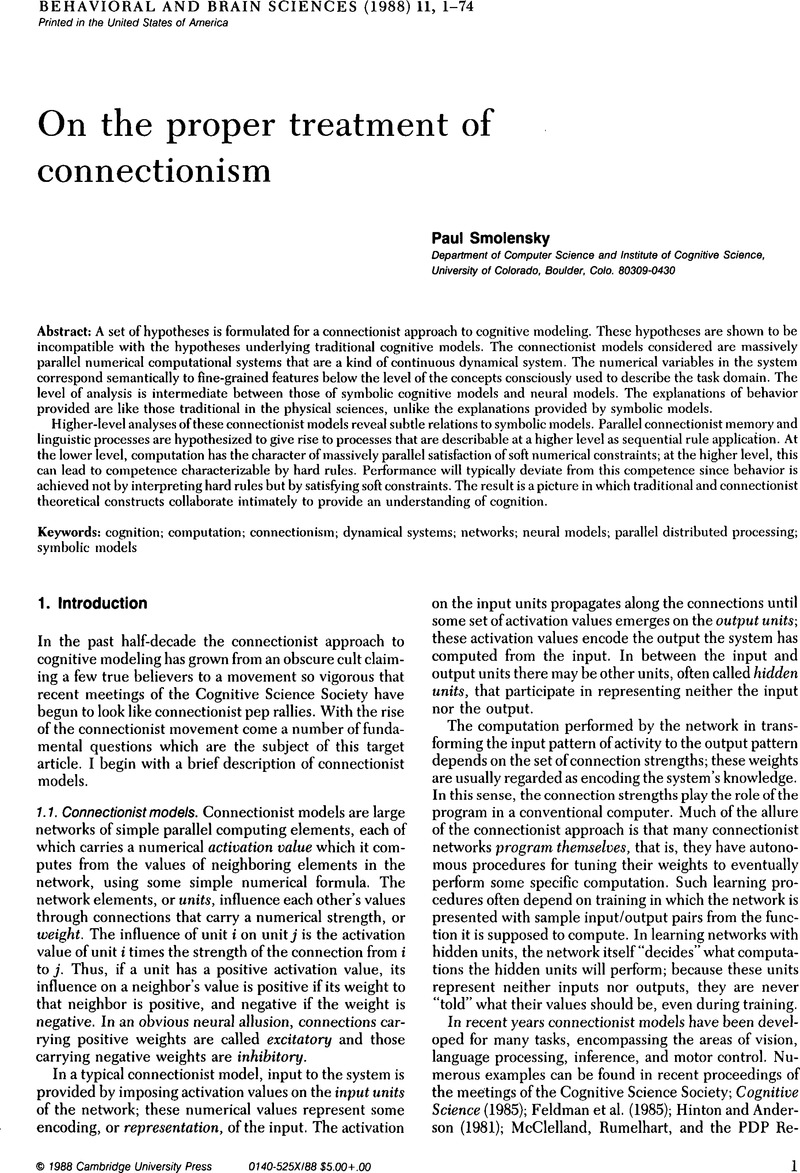Crossref Citations
This article has been cited by the following publications. This list is generated based on data provided by Crossref.
Levenick, James R.
1989.
A self-organizing perceptual system.
Behavioral and Brain Sciences,
Vol. 12,
Issue. 3,
p.
409.
Wagemans, J.
Verfaillie, K.
De Graef, P.
and
Lamberts, K.
1989.
Is extension to perception of real-world objects and scenes possible?.
Behavioral and Brain Sciences,
Vol. 12,
Issue. 3,
p.
415.
Findlay, John
and
Kentridge, Robert
1989.
More packaging needed before tags are added.
Behavioral and Brain Sciences,
Vol. 12,
Issue. 3,
p.
404.
Sun, Ron
and
Schalit, Emmanuel
1989.
Is the tag necessary?.
Behavioral and Brain Sciences,
Vol. 12,
Issue. 3,
p.
415.
Young, Malcolm P.
Paterson, Ian R.
and
Perrett, David I.
1989.
Attention to detail?.
Behavioral and Brain Sciences,
Vol. 12,
Issue. 3,
p.
417.
Butler, Brian E.
1989.
Do we need an early locus of attention to resolve illusory conjunctions?.
Behavioral and Brain Sciences,
Vol. 12,
Issue. 3,
p.
398.
Müller, Hermann J.
Humphreys, Glyn W.
Quinlan, Philip T.
and
Donnelly, Nick
1989.
Fundamental design limitations in tag assignment.
Behavioral and Brain Sciences,
Vol. 12,
Issue. 3,
p.
410.
Krueger, Lester E.
and
Stadtlander, Leann M.
1989.
Features and locations: Dichotomy or continuum?.
Behavioral and Brain Sciences,
Vol. 12,
Issue. 3,
p.
406.
Strong, Gary W.
and
Whitehead, Bruce A.
1989.
The value of modeling visual attention.
Behavioral and Brain Sciences,
Vol. 12,
Issue. 3,
p.
419.
Prinzmetal, William
and
Ivry, Richard
1989.
Damn the (behavioral) data, full steam ahead.
Behavioral and Brain Sciences,
Vol. 12,
Issue. 3,
p.
413.
Feldman, Jerome A.
1989.
Tags is for kids.
Behavioral and Brain Sciences,
Vol. 12,
Issue. 3,
p.
403.
Plaut, David C.
1989.
Neural networks and computational theory: Solving the right problem.
Behavioral and Brain Sciences,
Vol. 12,
Issue. 3,
p.
411.
Duncan, John
1989.
Parallel processing: Giving up without a fight.
Behavioral and Brain Sciences,
Vol. 12,
Issue. 3,
p.
402.
Hardin, C. L.
1989.
The bicameral retina at a glance.
Behavioral and Brain Sciences,
Vol. 12,
Issue. 3,
p.
405.
Aiple, F.
and
Fischer, B.
1989.
Synchrony of spikes and attention in visual cortex.
Behavioral and Brain Sciences,
Vol. 12,
Issue. 3,
p.
397.
Dawson, Michael R. W.
1989.
Constraining tag-assignment from above and below.
Behavioral and Brain Sciences,
Vol. 12,
Issue. 3,
p.
400.
Lesperance, Ronald M.
and
Kaplan, Stephen
1989.
A nonspatial solution to a spatial problem.
Behavioral and Brain Sciences,
Vol. 12,
Issue. 3,
p.
408.
Fields, Chris
1989.
Affordance perception and the Y-magnocellular pathway.
Behavioral and Brain Sciences,
Vol. 12,
Issue. 3,
p.
403.
Cave, Kyle R.
1989.
Visual attention and beyond.
Behavioral and Brain Sciences,
Vol. 12,
Issue. 3,
p.
400.
Dietrich, Eric
1989.
Is Thagard's theory of explanatory coherence the new logical positivism?.
Behavioral and Brain Sciences,
Vol. 12,
Issue. 3,
p.
473.


